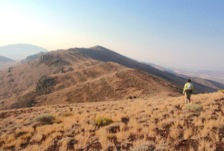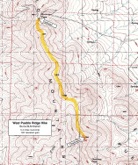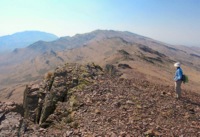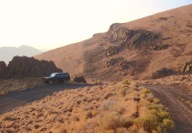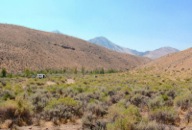Less Traveled Northwest
Day Hikes for the Adventurous
West Pueblo Ridge Hike
Hike Rating: Easy
Hike Length: 5.4 miles roundtrip (variable)
Elevation Gain: 720’
Trailhead Elevation: 6,320’
Best Season: June through September
Driving Access: Any vehicle, with care
Plus Points
• A scenic and cow free cross-country hike along a 7,000’-high ridge in the West Pueblos
• The West Pueblo Ridge is within a BLM Wilderness Study Area
• Long views of Oregon End Valley to the west, plus the Trout Creek and Steens ranges
• Easy walking over bunchgrass, low sagebrush and open shale fields
• Colorful yellow-green and orange lichen on exposed basalt outcrops
• Bighorn sheep sightings are more likely the further one hikes along the ridge
Minus Points
• Afternoon thunderstorms can present a lightning hazard along the ridge
• Hike can be hot in midsummer, so plan to start in the early AM and return by noon
Download (PDF, 522 KB): Photos of West Pueblo Ridge Hike
Download (PDF, 815 KB): Topo Map for West Pueblo Ridge Hike
Download (PDF, 756 KB): Road Map for West Pueblo Ridge Hike
Trail Notes
From the trailhead on a sharp switchback just below Domingo Pass, the hike climbs the rounded dome ridge to the south, switchbacking cross-country up the slope through bunchgrass and low sagebrush. The goal is to reach a bench just below and east of Point 6767, a prominent basalt outcrop with a 4'-high stacked rock cairn on top. From this bench, one has a long view south along the ridge and can see hike ahead. The route then follows the broad spine of the ridge south, gradually descending and ascending with the topography. All along the ridge top, one has great views west of the vast Oregon End Valley and its remote tablelands. Look for sage grouse on the slopes below the ridge.
At the 1.3 and 1.7 mile points, one crosses two rounded promontories with long views back north to Alvord Peak, the south end of the Steens escarpment and the High Steens beyond. There are also long views to the east, over the Pueblo Valley, to the Trout Creek Mountains. After about 2 miles along the ridge, one begins to encounter striking basalt outcrops covered in yellow-green and orange lichens.
From this point south, signs of bighorn sheep (hoof prints, scat and trails) are much more prevalent and it's worthwhile to scan the dark ridges and rims ahead with binoculars. One can hike as far south as one likes along the ridge, but Promontory 7042 at the 2.7 mile point, just north of Oleachea Pass, can make a good day hike destination.
Road to Trailhead
Drive about 3.1 miles south from Fields Station on the paved Fields-Denio highway and look for a signed turnoff to Domingo Pass on the west. If dry and hard, turn onto this road and follow it for about 7.4 miles, keeping on the main graded route at all road junctions. At the 4.6 mile point, just after passing a yellow cattle guard, there's a fork in the road, with each fork looking like the primary route — but the road to the right leads to the pass. Just before the top of Domingo Pass, look for a sharp switchback to the south. Park on this switchback, just below a jagged outcrop of shale, taking care not to block the roadway.
When dry, the road to Domingo Pass can be traveled by any passenger car, as the roadbed is occasionally graded. Approaching the top of the pass, there are a few exposed rock ledges in the road to negotiate but, with care, one can drive over and around them.
Camping Options
There are no developed campgrounds within 25 miles of the Pueblo Mountains. Both the Willow Creek Hot Springs Campground near the Trout Creek Mtns. and the Mann Lake Recreation Area east of Steens Mtn. are too distant to serve as a base for day hiking here.
The best option is dispersed camping along the access road to Little Cottonwood Creek, about 7.7 driving miles south of Fields Station. You'll need to provide your own water and sanitation, but there are 6-8 dispersed camp sites here spread out along the creek, all within a half mile of the highway. These camping sites have no tree cover or shade and the access road gets rougher the further one drives up the canyon — but any size camping setup, from small tents to large RVs, can find a spot here. The surrounding hills provide some protection from the winds and there is also good privacy from the highway.
Agency Contact: Burns BLM District, (541) 573-4411
DISCLAIMER: Every effort has been made to ensure the accuracy of this information, but the authors do not guarantee that it is either current or correct. The reader assumes full responsibility for any use of this information, and is encouraged to contact local federal land agencies to inquire about current conditions before traveling.
Page last updated: 1/17/13

